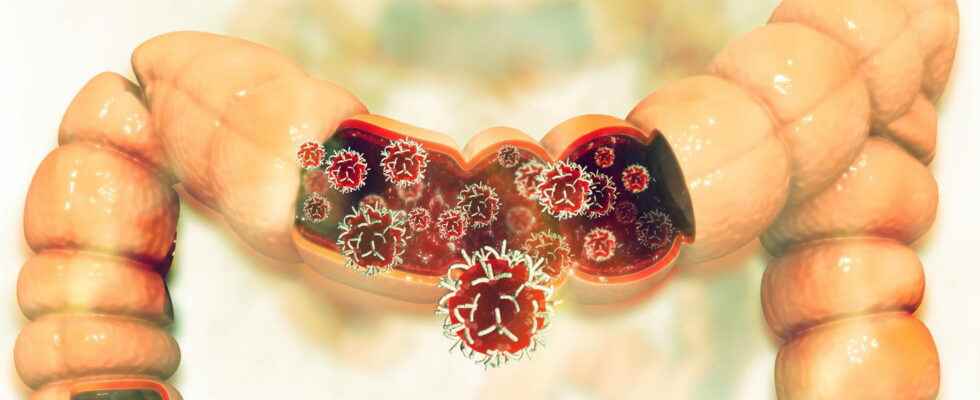Lieberkühnian adenocarcinomas are tumors that develop in the glandular tissue of an organ. Colon and rectal cancer is a lieberkühnian adenocarcinoma in 85% of cases. Symptoms, prognosis and treatment.
Definition: what is a lieberkühnian adenocarcinoma?
A lieberkühnian adenocarcinoma is a cancerous tumor which develops at the level of the glandular cells (known as by Lieberkühn) digestive mucosa. Adenocarcinoma can be found on the entire digestive circuit, but it is mainly the colon and the rectum that are affected. “Type of colon and rectal cancer is lieberkühnian adenocarcinoma in 85% of cases“, specifies Dr. Benoit Gignoux, digestive surgeon at the Clinique de la Sauvetage in Lyon. According to the French National Society of Gastroenterology, colorectal cancer is the third most common cancer (after prostate and breast cancer) with 45,000 new cases and 18,000 deaths per year.
What are the symptoms of lieberkühnian adenocarcinoma?
The most frequent symptoms are abdominal pain, changes in transit or the presence of blood in the stool. However, the signs may be discreet or even absent, especially if the lieberkühnian adenocarcinoma is located on the right side of the colon. In this case, it may lead to occult bleedingthat is to say a progressive anemia which the patient does not realize because the blood is mixed with the stool. If the adenocarcinoma involves the rectum (or terminal part of the colon), the patient may feel pain in the pelvisbowel movements, red blood in the stool or rectal bleeding. In case of advanced cancerthe tumor can obstruct the passage of stool and cause an occlusion, it is then a surgical emergency.
What is the cause of appearance of a lieberkühnian adenocarcinoma?
Adenocarcinoma always grows out of a colon polyp. A polyp is a benign tumor which corresponds to an abnormal multiplication of the cells of the mucosa then becoming a polyp or adenoma. These polyps take several years to form and, over time, some transform and become cancerous: the adenoma then becomes an adenocarcinoma or invasive cancer. “There are not always identified causes to the appearance of adenocarcinoma. However, risk factors are currently well identified: age over 50, physical inactivity, obesity, consumption of alcohol or tobacco and a diet rich in red meat or cold cuts. On the other hand, regular physical activity and a diet rich in fruits and vegetables are protective.“, explains Dr. Gignoux. Some inflammatory bowel diseases such as Crohn’s disease or hemorrhagic ulcerative colitis present an increased risk of colon cancer. Finally, there are also genetic factors such as Lynch syndrome (or colon cancer familial) and familial adenomatous polyposis which are rare but predispose to colon cancer before the age of 40.
“Diagnosis is made using a colon endoscopy or a colonoscopy either because the patient has been screened for cancer, which turned out to be positive, or because he suffers from abdominal pain, transit disorders or blood in the stool.“The patient must then drink a preparation to empty the colon of its stools in order to better see the wall of the mucous membrane. The examination is carried out under light anesthesia and usually lasts between 15 and 30 minutes. Thanks to the introduction of a camera through the anus with insufflation of air or CO2, the doctor can thus explore the entire colonic mucosa. “If a polyp is found, it is removed during the examination. If a tumor is suspected, we realize a biopsy which will be analyzed in the laboratory. The results are received the following week. “If it is a case of colon cancer, we perform a full report which includes blood tests as well asa CT scan of the chest and of the abdomen to check for the presence or absence of metastases“, specifies Dr. Gignoux.
To cure colon cancer, only surgery is curative. The surgery (called colectomy) includes resection of part of the colon and adjacent lymph nodes and then reconstruction of the digestive circuit by a suture between the remaining part of the colon and the rectum. Colectomy is most often done by laparoscopy with a hospitalization for 2 to 5 days as well as a modern peri-operative management of improved rehabilitation after surgery (RAC). With regard to rectal cancer, pre-operative treatment comprising of radiotherapy with or without chemotherapy is most often offered. This preoperative treatment is then followed by a resection of the rectum with reconstruction. Depending on the stage of the colorectal cancer, additional chemotherapy to surgery may be offered.
What is the prognosis with lieberkühnian adenocarcinoma?
“The prognosis depends on the stage of the adenocarcinoma, i.e. its extension deep into the colon (T), whether or not the lymph nodes are affected (NOT) and the presence of metastases (M): this is the classification TNM. In case of non-metastatic colon cancer, the prognosis is good with curative surgery. The prognosis may be more guarded in the case of cancer at the metastatic stage. In this case, only 10 to 20% of patients will benefit from curative treatment while the others will have treatment to stabilize the disease.” In order for the cancer to be treated as soon as possible, it is important to carry out colorectal cancer screening which is now recommended from the age of 50. This is an immunological test at the stool level that can detect the presence of occult bleeding. In the event of a positive test, a colonoscopy will be performed in order to remove the polyps or adenomas before they turn into cancer. “Given the high mortality of colorectal cancer, it is very important that the whole population takes this test.“
Thank you to Dr. Benoît Gignoux, digestive surgeon at the Clinique de laSauveur in Lyon.
Source: French National Society of Gastroenterology
